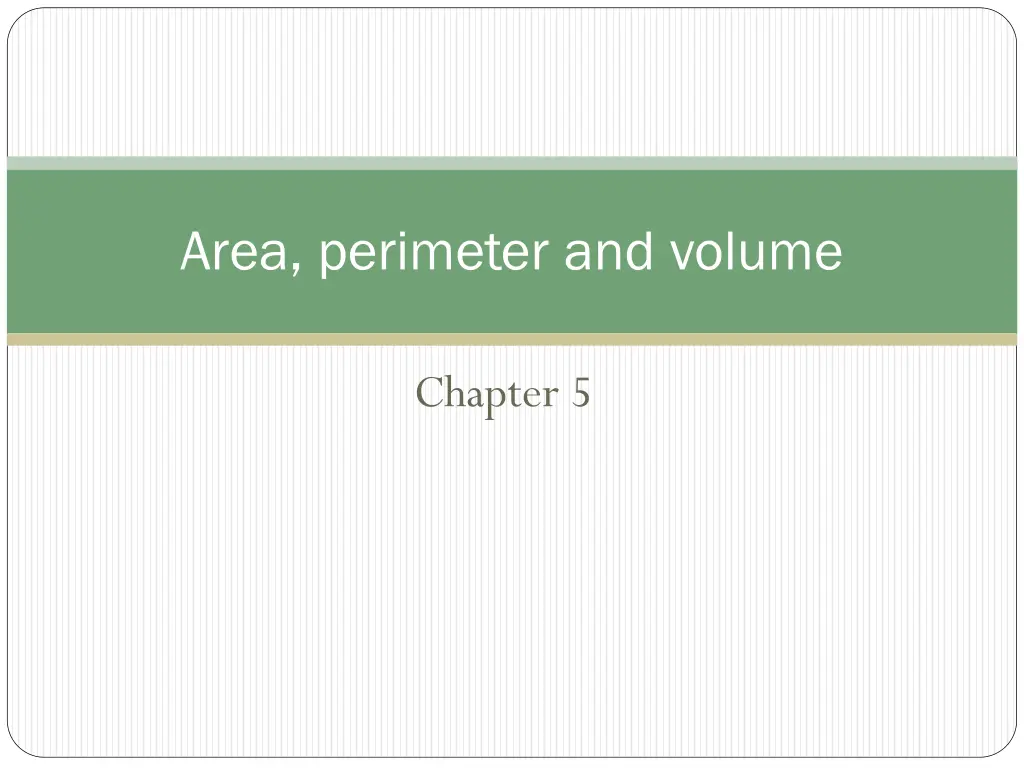
Understanding Area, Perimeter, and Volume in Geometry
Explore the concepts of area, perimeter, and volume in Chapter 5 with a focus on circles, parallelograms, and trapeziums. Learn about important circle properties, circumference calculations, and properties of parallelograms. Dive into examples and exercises to strengthen your understanding of geometric concepts.
Download Presentation

Please find below an Image/Link to download the presentation.
The content on the website is provided AS IS for your information and personal use only. It may not be sold, licensed, or shared on other websites without obtaining consent from the author. If you encounter any issues during the download, it is possible that the publisher has removed the file from their server.
You are allowed to download the files provided on this website for personal or commercial use, subject to the condition that they are used lawfully. All files are the property of their respective owners.
The content on the website is provided AS IS for your information and personal use only. It may not be sold, licensed, or shared on other websites without obtaining consent from the author.
E N D
Presentation Transcript
Area, perimeter and volume Chapter 5
Objectives: Objectives: To learn about ? and the circumference of a circle. To learn about area of a parallelogram and a trapezium.
Circle parts Circle parts Chord: is a straight line from one point on the circumference to another. Segments: a chord splits a circle into two segments. Arc: is part of the circumference. Sector: is formed by joining a radius to an arc to a radius. Circumference: is the distance around a circle. It s basically the term used to describe the perimeter of the circle. Diameter: the length of a line passing through the center from one point on the circle to another. Radius: the length of a line drawn from the center to any point on the circle.
Important things to know about a circle Important things to know about a circle The diameter and radius are very important to work out the circumference and area of any circle. You also notice that both rules (area and circumference) will use the Greek letter (known as pi, pronounced as pie). is about 3.14 rounded to 2 d.p. diameter = d radius = r Diameter = 2 radius = 2r to learn more about , please watch the video below: https://www.youtube.com/watch?v=cC0fZ_lkFpQ&t=6s
Circumference of circles Circumference of circles The rule to find the circumference of a circle is as follows: Remember that the diameter is 2 radius OR (2r). Therefore, if a question gives you the diameter instead of the radius, you may use the rule below. To understand more, please watch the video below: https://www.youtube.com/watch?v=O-cawByg2aA&t=300s
Examples: Find the circumference of the circles below: Circumference = d Circumference = 2 r = 3.14 6 = 18.84 cm = 2 3.14 4 = 25.12 cm
P. 67 Ex.5A: Q1 Q2 (b, d) Q3 (b, d) Q4 Q5 Q8 (a, b) Q15 (a, c, d, e)
Area of Parallelograms Area of Parallelograms Properties of a parallelogram: It has two pairs of opposite parallel lines. Every two opposite sides are equal to each other (congruent). Every two opposite angles are equal to each other. Two of which are acute, and two are obtuse. Interior angles add up to 360o.
Area of Parallelograms Area of Parallelograms Please watch the video below: https://www.youtube.com/watch?v=PKzE3OWxDfQ So, you will notice from the video that finding the area of a parallelogram is the same as a rectangle. But instead of using the length and the width, you will use the base and the height. Therefore, you can find the area of a parallelogram using the rule: Area = Base height
Sometime, the question might give you the area and ask you to find a missing side. In such cases, use inverse operation to find the missing side (just like we did in rectangles). Please refer to slide 4. Example: the area of the parallelogram is 43 cm2. what is the height of the parallelogram? Area = base x height 43 = 10 x h h = 43 10 so the height is 4.3 cm. P. 69 Ex.5B: Q1 (b), Q2 (a), Q4 and Q5 (b)
Area of Trapeziums Area of Trapeziums First please start by watching the video below: https://www.youtube.com/watch?v=ludxEuznIRs So for any trapezium, you can find the area of it using the rule: Area = ? ? ?? + ?? ? Of course, using the commutative law, some might write it this way which is okay. b1 Area = ? ? ? ?? + ?? b2
Example: Find the area of the trapezium below. Answer: Area = 1 2 8 (4 + 10) = 4 14 = 56 cm2 Sometime, the question might give you the area and ask you to find a missing side.
For Example: Find the length of the height, if the area is 72m2. Answer: Area = 1 72 = 1 2 (30 + 18) h 2 48 h 72 = 24 h (divide by 24 on both sides) Use what you learned in algebra h = 3 m P. 70 Ex.5C: Q3 , Q4 To review again: please watch the link below: https://www.youtube.com/watch?v=Y1_SbgUbgPY
Compound shapes Compound shapes P. 72 Ex.5D: Q1 (a, d) Q3 (b, d) Q4 Q5 Q8
